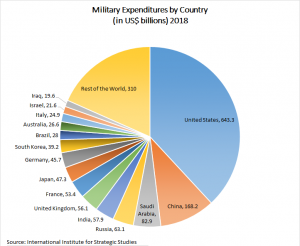President Dwight D. Eisenhower used the term Military Industrial Complex (MIC) in his Farewell Address to the United States in 1961:
“This conjunction of an immense military establishment and a large arms industry is new in the American experience. The total influence—economic, political, even spiritual—is felt in every city, every statehouse, every office of the federal government. We recognize the imperative need for this development. Yet we must not fail to comprehend its grave implications. Our toil, resources and livelihood are all involved; so is the very structure of our society. In the councils of government, we must guard against the acquisition of unwarranted influence, whether sought or unsought, by the military–industrial complex. The potential for the disastrous rise of misplaced power exists and will persist. We must never let the weight of this combination endanger our liberties or democratic processes. We should take nothing for granted. Only an alert and knowledgeable citizenry can compel the proper meshing of the huge industrial and military machinery of defense with our peaceful methods and goals so that security and liberty may prosper together.”
Eisenhower explained how the MIC could hurt the nation if the government spent too much money on military weapons. While the POTUS talked about the MIC in a new way, the idea itself was not new. Nor would it end in the years to follow.
The First Era
From the beginning until 1941, the U.S. government used its people to make arms during wartime. The government owned shipyards and munitions factories. World War II changed the picture.
FDR created the War Production Board to use civilians to make weapons for war. The people made a great deal of money at that time. The War ended but the WPB stayed in place. Private companies began to supply services to the government to outfit the military.
The Second Era
The Second Era began with the withdrawal of the Warsaw Pact in 1990 and the downfall of the Soviet Union in 1991. The Pentagon asked defense contractors to unite to work within the defense budget, which had been cut.
The Third Era
The Third Era is the state of the Military-Industrial Complex from 1992-present. Defense contractors make other goods, from weapons to other items including surveillance, nanotechnology, 3D printing, and other advancements. Large companies merge with smaller businesses to create bigger companies worth billions of dollars. The Department of Defense imports many forms of technology, but no longer shares them on the open market.
Private industry creates more opportunities for technology companies, but defense contractors have a strong hold on making weapons for the government, just as former military officers cash in on their experiences.

